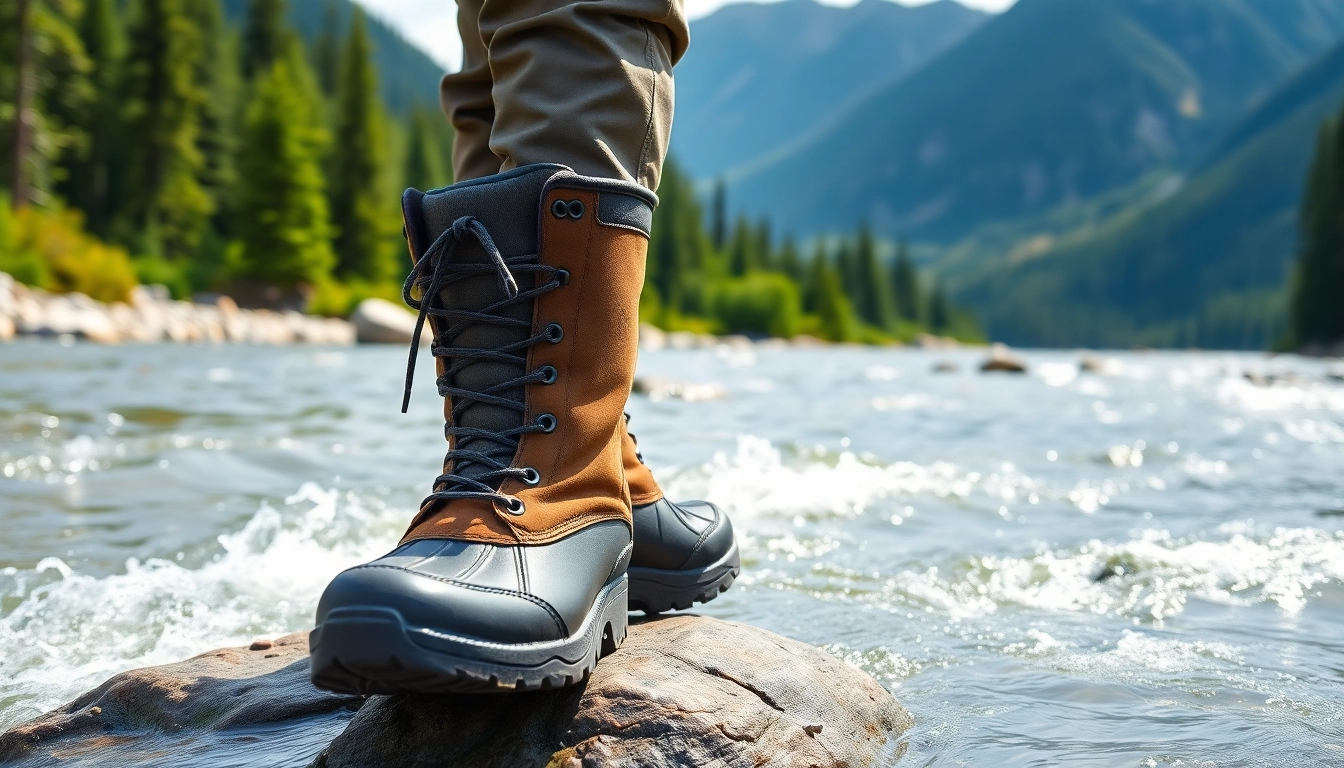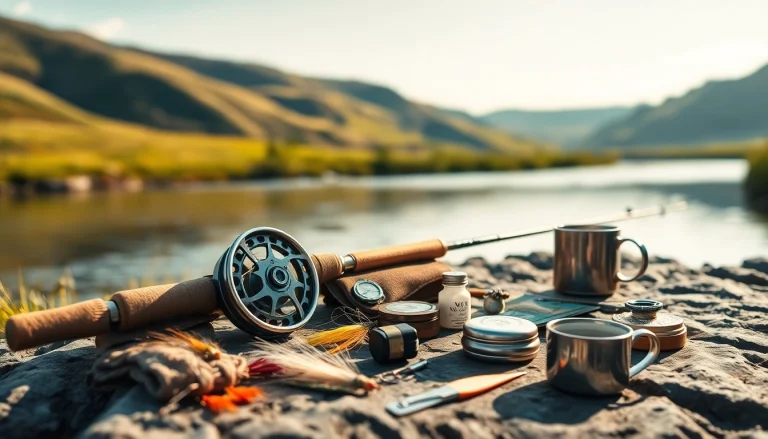Understanding the Importance of Fly Fishing Boots
When it comes to fly fishing, having the right gear can make all the difference between a successful day on the water and an uncomfortable, unproductive experience. One piece of equipment that often garners less attention than rods and reels, yet is critical to success, is your choice of footwear. Fly fishing boots are not just a comfort element; they are a protective barrier between you and the elements. Many anglers overlook the significance of quality in fly fishing boots, leading to discomfort and even safety issues while wading through different water conditions. Investing in a quality pair of fly fishing boots is vital for both your performance and overall enjoyment.
Why Quality Matters in Fly Fishing Boots
The primary reason quality matters in fly fishing boots revolves around safety and durability. For those venturing into slippery rivers and rugged terrains, boots that promise better grip and resilience can prevent accidents. A well-constructed boot made from durable materials will last through various fishing seasons, reducing the need for frequent replacements. Furthermore, quality boots often provide better ankle support, significantly decreasing the risk of sprains during slippery conditions.
Additionally, comfort cannot be understated. Spending hours standing in water or trekking to fishing locations requires boots that offer support and cushioning. Innovative materials and designs used in premium boots can aid in reducing fatigue, allowing you to focus on the fishing aspect rather than discomfort.
Common Features of Fly Fishing Boots
When evaluating different fly fishing boots, certain features emerge as common yet essential across various models:
- Waterproofing: Most reputable boots are equipped with waterproof materials to keep your feet dry while wading.
- Breathability: Good fly fishing boots also include ventilation options to allow moisture to escape, preventing excess sweat accumulation inside the boot.
- Traction: Specialized soles designed for traction are crucial for navigating slippery rocks and uneven terrains.
- Ankle Support: High-top designs or reinforced ankle sections offer extra support and stability, which is especially valuable when walking on uneven ground.
- Drainage: Many fly fishing boots are designed with drainage channels to allow water to escape, minimizing the extra weight of water-logged boots.
How Fly Fishing Boots Enhance Your Experience
The right boots can enhance your overall fly fishing experience by increasing comfort and efficiency in several ways. Firstly, boots designed for fly fishing improve your stability and balance in water, enabling you to access prime fishing spots that might otherwise be dangerous to reach. Secondly, with better insulation and waterproofing, you can fish during cold seasons or unexpected weather shifts without fear of compromising foot comfort.
Moreover, the convenience of features like quick-drying materials and removable insoles adds a layer of practicality that can facilitate easier maintenance and better hygiene. When your gear is well-suited to the demands of fly fishing, the focus shifts to enjoying the serene beauty of your surroundings and the thrill of the catch.
Types of Fly Fishing Boots
Understanding the various types of fly fishing boots available can help you make an informed decision tailored to your fishing style and environment. Not all boots are created equal, and the type you choose should directly correlate with your intended fishing activities.
Wading Boots vs. Hiking Boots
Wading boots are specialized footwear designed explicitly for use in water. These boots typically feature a rugged sole with enhanced traction for stability on slippery rocks, as well as waterproof materials to keep your feet dry while wading. On the other hand, hiking boots are constructed for land-based activities, offering excellent support and comfort while trekking to fishing spots but may lack the specialized features needed for waterborne activities.
If your fishing adventures involve substantial wading, investing in dedicated wading boots is essential. However, if you mostly hike to reach lakes or remote streams without needing to wade, a robust pair of hiking boots can suffice. Some anglers prefer a combination of both, with versatile footwear that works well on both land and water.
Material Options for Fly Fishing Boots
The material of your fly fishing boots plays a significant role in their effectiveness and longevity. Common materials include:
- Neoprene: Known for its insulation and cushioning, neoprene is often used in boots that require warmth for cold-weather fishing.
- Leather: Durable and long-lasting, leather provides excellent waterproofing but may require more maintenance than synthetic options.
- Synthetic Fabrics: Lightweight and often more breathable, synthetic materials can offer comfort and some level of waterproofing while being easier to maintain.
Ultimately, the choice of material should depend on the conditions you’ll face while fishing, with considerations for weight, insulation needs, and durability.
Choosing the Right Sole for Your Environment
The sole of your fly fishing boots is crucial for traction and stability. Depending on where you fish, you might need specific sole types:
- Rubber Soles: These are popular for their excellent grip on wet surfaces and are generally preferred in rocky streams.
- Filament Soles: Often used for their traction, filament soles are great for mud and looser terrain.
- Studded Soles: Some boots feature the option for metallic or plastic studs that can be added for improved grip on the slippery surfaces commonly found in rivers.
Choosing the right sole involves evaluating where you will primarily fish and what conditions you might encounter, as improper soles can compromise your safety and fishing efficiency.
Fit and Sizing for Fly Fishing Boots
A boot that fits well enhances comfort and performance significantly, making the fit and sizing a crucial aspect of your buying decision.
How to Measure Your Feet for the Best Fit
Accurate foot measurement is essential for achieving the perfect fit. To measure your feet:
- Prepare Your Tools: You’ll need a ruler or measuring tape, and a piece of paper.
- Trace Your Foot: Stand on the paper and trace around your foot. Repeat for both feet, as one might be slightly larger than the other.
- Measure the Length and Width: Measure the longest points of your foot tracing and note the width as well.
Compare these measurements with the sizing charts provided by the manufacturer to determine the best size for you.
Considerations for Sock Pairing with Fly Fishing Boots
The type and thickness of socks you choose can significantly influence the fit of your fly fishing boots. Thick wool socks can provide warmth and cushioning but may make the fit snugger, especially in boots that are already tight. Conversely, thinner synthetic socks can enhance breathability and moisture-wicking, especially in warmer conditions.
A good practice is to try your boots on with the type of socks you plan to wear, ensuring that they fit comfortably and that your toes have some wiggle room without being overly loose.
Testing Fit: A Step-by-Step Guide
After measuring your feet and selecting a size, testing the fit in-store or when trying them on at home is crucial. Follow these steps:
- Slip On: Ensure you can easily slip your foot into the boot without too much resistance.
- Walk Around: Take a few steps to assess comfort and responsiveness of the boot.
- Check the Heel: Your heel should stay in place without lifting as you walk.
- Sit Down: Bend and flex your feet while sitting to check for pressure points or unnecessary tightness.
A foot that feels comfortable and secure will translate to better performance on the water.
Maintenance Tips for Longevity of Fly Fishing Boots
Proper maintenance is essential for extending the life of your fly fishing boots, which can be a significant investment over time.
Cleaning Your Fly Fishing Boots Properly
To care for your fly fishing boots, follow these cleaning steps:
- Remove Excess Dirt and Debris: Use a brush or damp cloth to wipe away any surface dirt or debris after each use.
- Rinse with Water: If the boots are muddy, rinse them clean to prevent buildup.
- Clean Soles: Pay special attention to the soles, as algae and mud can compromise traction.
- Dry Thoroughly: Allow your boots to dry completely after washing, avoiding direct sunlight and heat sources that can degrade materials.
Storage Recommendations for Fly Fishing Boots
How you store your fly fishing boots can also affect their lifespan. Follow these guidelines:
- Choose a Cool, Dry Location: Store your boots in a cool, dry place to avoid mold and mildew.
- Avoid Compression: Stuff the boots with paper or use a boot tree to maintain their shape during storage.
- Keep Away from Extremes: Avoid leaving boots in cars or areas subjected to temperature extremes that can deteriorate materials.
Signs It’s Time to Replace Your Fly Fishing Boots
Knowing when to replace your boots is crucial for maintaining performance and safety. Look out for:
- Worn Soles: When the tread is worn smooth, traction can become unreliable.
- Cracks or Tears: Any significant damage to the material, especially anywhere near the waterproofing features, can compromise their integrity.
- Loss of Support: If your boots no longer hold your ankle properly or lack cushioning, it might be time for new ones.
Top Brands and Models of Fly Fishing Boots
While this article will not delve into promoting specific companies, understanding how to evaluate different brands and models can significantly enhance your shopping experience.
Evaluating Features Across Different Brands
Not all boot brands are created equally; therefore, look for brands that prioritize quality manufacturing, innovative materials, and customer feedback. Compare features such as waterproofing, breathability, and traction systems across models to find the best fit for your needs.
Customer Reviews: What to Look For
Customer feedback can provide invaluable insight when selecting a boot. When reading reviews, focus on:
- Comfort and Fit: Are the boots comfortable over long periods?
- Durability: Do users report lasting quality, or are there frequent complaints of issues?
- Value for Money: Does the performance justify the price point?
Comparing Prices and Value of Fly Fishing Boots
Fly fishing boots come in a wide range of prices, so understanding what you get for your money is critical. Analyze the features and durability in relation to their price tags; cheaper options may save money initially but could lead to replacements sooner. Investing in quality often pays off in the long run.
Ultimately, understanding the different types of fly fishing boots, their features, fit, maintenance, and brand evaluations, equips you to make an informed decision. By focusing on what matters — comfort, safety, support, and durability — you can select the perfect pair of fly fishing boots to elevate your fishing experience.








